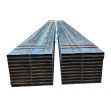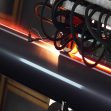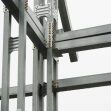How to look at glazing methods and their impact on performance for curtain wall buildings
Modern curtain wall systems primarily utilize two materials, aluminum and glass. The walls or rooftops are typically framed with aluminum alloy because it accommodates almost any shape while also being strong and lightweight. The aluminum frames are then glazed with curtain wall panels. Glass has become the preferred material choice for the panels because of its variety of colors, thickness, and opacity. It gives buildings an ultra-modern appearance while also allowing for the maximum amount of natural light inside.

Glazing is regarded as the vital part of the building facade in applications, which allows certain elements of nature to come into the internal space. These years, modern curtain wall tends to use double or triple glazed. It’s also fully integrated with any type of opening windows and all types of patio doors. Generally speaking, there are four typical glazing methods widely used in curtain wall construction as follows:
1. Pressure Plate Glazing:
In this system, the glass and infill panels are installed from the exterior, typically against dry gaskets. The outer layer of gaskets is installed and the gaskets are compressed against the glass by the torque applied to fasteners securing a continuous pressure plate. And this type of curtain wall glazing provides reasonable performance but is susceptible to leaks at corners or joints in dry gaskets. For improved performance four-sided gaskets can be fabricated at additional cost or wet sealants can be installed to provide a concealed interior toe bead or exposed interior cap beads. Pressure plate glazing allows the easiest method to seal an air barrier from adjacent construction into the air barrier of curtain wall system.
2. Interior Dry Glazing:
In this system, glass and infill panels are installed from the interior of the building, eliminating the need for substantial scaffolding and saving money. And the curtain wall frame is fixed and exterior dry gaskets are installed. Typically only the top interior mullion has a removable stop. The glass unit is slid into a deep glazing pocket on one jamb far enough to allow clearing the opposite jamb and is then slid back into the opposite glazing pocket and then dropped into the sill glazing pocket. The removable interior stop is installed and finally an interior wedge gasket is forced in. Sometimes this method is called “jiggle” or “wiggle” glazing because of the manipulation necessary to get the glass into place. Performance is slightly reduced because dry metal to metal joints occur at the ends of the removable stop at a point that should properly be air and watertight.
3. Structural Silicone Glazing:
In this system, glass or infill unit is adhered to the frame with a bead of silicone. Outer silicone weather seals supplement the structural seal. Unitized curtain wall systems are frequently structural silicone glazed, especially if four-side SSG is desired. Two-sided SSG, with pressure plate glazing or wiggle glazing on the other two sides is acceptable to be field installed.
4. Butt-Glazing:
SSG is frequently mistakenly considered butt-glazing. True butt-glazing has no mullion or other back-up member behind the joint and relies solely on a sealant, typically silicone, between the glass units to provide a perfect barrier seal.
Tel: +86 18202256900 Email: steel@tjdpbd.com









